Affiliate disclosure: This post may contain affiliate links. Please see our Privacy Policy.
Mead making goes back millennia, and honey wines have been found at archeological sites from around 10,000 BC. Humans have been making mead for a very long time, well before the advent of fancy brewing equipment.
Making mead at home need not be complicated, and just about anyone can make homemade honey wine.
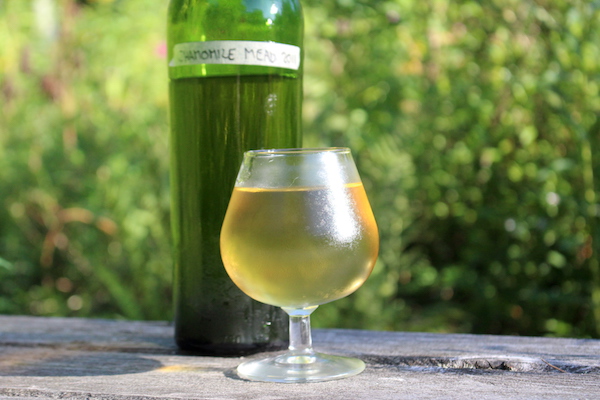
The first time I drank mead was just after my 21st birthday, at a two-week-long medieval reenactment camp run by the SCA (Society for Creative Anachronism). A bunch of us piled into the car and drove 10 hours to Western Pennsylvania for Pennsic, an elaborate medieval camping festival featuring more historical nerdery than you can shake a mead horn at.
One of my friends started a quick mead in a soda bottle, literally on the ride down. One part raw honey, three parts water and a lot of shaking made the “must.” Since it was raw honey from a local farm, it already contained wild yeasts and began bubbling before we arrived. They attached a balloon with a pinhole to the top of the bottle as a water-lock, and two weeks later on the last day of the festival we celebrated with our own hacked together batch of quick mead.
That, of course, was after sampling high-quality mead from some of the best mead makers in the country all week long. Bearded men and buxom ladies filled my glass with long-aged high-quality meads that had been started back when I was in grade school, plus plenty of experimental meads with everything from chili peppers to fennel.
Even after being spoiled with exceptional meads for two weeks straight, our hacked together batch was still darn good. Was it a 10-year oak barrel-aged mead? Nope. But I learned that mead is spectacular, and like pizza, even bad mead is still pretty darn good.
I was hooked, and now we’ve been brewing our own homemade mead for well over a decade. My husband and I made a batch of dandelion mead on our first date just over 10 years ago, and we still enjoy a bottle of it every anniversary.
There are more than 200 bottles aging down in our basement, and we’ve learned a lot about how to make truly exceptional mead at home. Believe it or not, it’s easier than you think.
Sure, I don’t make it in plastic soda bottles capped with a balloon airlock anymore, but it can be done. Don’t overcomplicate things and you’ll be a happy mead maker!
Equipment for Making Mead
If you’ve never made any type of homemade wine or beer, let me help you understand basic mead making equipment:
- Fermentation Vessel (x2) ~ Generally a glass one-gallon jug known as a demijohn. For larger batches, you can also use a 5-gallon demijohn or a plastic brewing bucket. It helps to have two so that you can siphon the mead into a clean container for secondary.
- Water Lock ~ Often the demijohns will come with a rubber stopper and water lock, but if not, you’ll need one to seal the jug. A water lock is a one-way valve that allows CO2 to escape, but doesn’t let contaminants get into the mead. Keep in mind the opening on a 5-gallon demijohn is larger and you’ll need a bigger rubber bung if you’re using a 5-gallon setup.
- Auto Siphon ~ Optional, but highly recommended. A siphon allows you to efficiently move the mead from one container to another, leaving the clouding sediment behind in the previous container. Sure, you can just pour, but it gets messy quick and aerates the mead which can impact quality. It’s also really handy at bottling time.
- Wine Bottles ~ Any clean, sterilized wine bottles can be reused for bottling, or they’re available online already de-labeled and clean.
- Corks ~ Only use new corks for a good seal and to prevent contamination.
- Bottle Corker ~ There are a few types, but I recommend the double lever variety. It’s only about $10-12.
- Sanitizer ~ A one-step sanitizer cleans all equipment quickly, and won’t leave any residue to interfere with your mead making.
Assuming you clean your own bottles (since those are the most expensive part), you can buy reusable equipment that’ll allow you to make dozens of batches for about $50. Not bad when a bottle of mead goes for $20-$30 around here. Now all you need is honey…
How to Make Mead
Making mead at home is incredibly easy, don’t make the mistake of overthinking it! Once you understand the basics of mead-making, the next step should involve getting your hands on yeast and honey.
Start by adding one part honey and three parts water to a fermentation vessel. For a one-gallon batch, that means one-quart honey (about 3lbs) and three quarts water. Mix thoroughly until the honey is completely dissolved.
Some people choose to boil the honey/water mixture to sterilize it, but this is unnecessary and will change the flavor of the finished mead. The added yeast will quickly overwhelm and outcompete any of the wild yeasts present in the honey.
Next, add wine or mead yeast to the mixture. Raw honey straight from the hive already contains natural yeast, in truth all you need is to add water in the right proportion and allow the little beasties to go to work.
Most honey you can buy is heavily filtered and often heated in bottling, so it’s best to add a bit of commercial mead yeast anyway for more consistent results. That said, I’ve made plenty of wild fermented meads with excellent results, but I’d suggest sticking with added yeast as you’re learning the process.
The yeast can have a pretty dramatic effect on the finished mead, and you want to choose a yeast that has a high enough alcohol tolerance to fully ferment the honey. A good place to start is Lavin-D47, and if you want to get more into it, you can read this article on the best yeast for mead.
Add in any optional additives, such as fruit, herbs or winemaking additives (tannin, etc). All of these are optional and will flavor your homemade mead or help it ferment more efficiently. The only additive I do suggest adding to each batch is either 1 teaspoon of yeast nutrient (or a handful of raisins) per gallon. Honey is a complex sugar, and it’s harder for the yeast to metabolize than straight sugar or fruit sugar.
Adding a few micronutrients helps them along in the process, and few historical Viking meads would have been made with just honey and water without something else added. They may not have known it was feeding the yeasts, but they did know that it resulted in a better mead.
Seal the fermentation vessel with a water lock to create a one-way valve. This will allow the CO2 created during fermentation to escape, but it won’t allow contaminants to enter. The main contaminant you’re worried about is acetobacter, or vinegar producing bacteria that can turn your mead into vinegar.
Historically, water locks weren’t available and they’re not strictly necessary to make mead. That said, bottling technology wasn’t available until relatively recently, and the Vikings were drinking their mead fresh before it had a chance to turn to vinegar. If you plan to bottle and store the mead, which greatly improves the finished flavor, it’s important to use a water lock.
Bubbles should be present with 24 hours, and the first week or so will be very active fermentation. Allow the mead to ferment for 2-3 weeks, until fermentation slows. This is called primary fermentation.
After 2-3 weeks, use a siphon to move the mead to a new container for secondary fermentation. This process is called “racking.” The sediment is left behind in the primary fermentation vessel, which helps to clarify the mead and prevents the sediment from imparting any off-flavors in the finished mead.
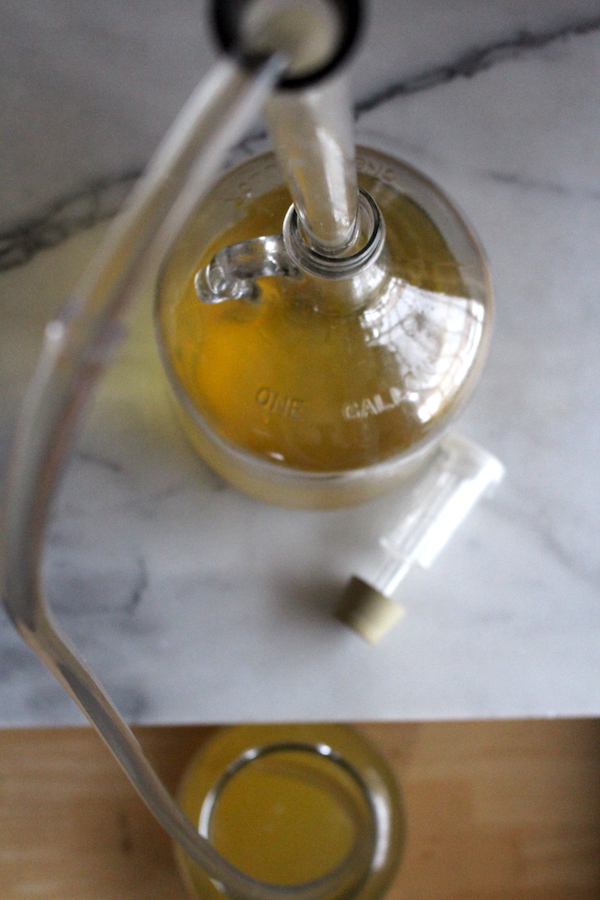
Racking is optional, but really improves the quality of the finished mead.
Allow the mead to ferment in secondary for at least 6 weeks, or as much as 6 months. Longer will usually improve the mead, but it’s up to your level of patience.
If you’re choosing not to rack into secondary, just leave it in primary for 8 weeks before bottling. That’s fine too.
For bottling, I’d strongly recommend using wine bottles and corks. Mead improves with age, and we’ve got 10+-year-old bottles in the basement that get better every year. If you bottle with beer bottles or flip-top Grolsch bottles, the mead won’t be able to “breathe” and it won’t age nearly as well.
Use a racking siphon to fill clean, sterilized wine bottles with mead (again, leaving the sediment behind in the fermentation vessel). Soak the corks in boiling water for an hour or so to help soften them, and then they’re ready to be inserted with a bottle corker. (Either the simple plunger corker or a much more efficient double lever corker.)
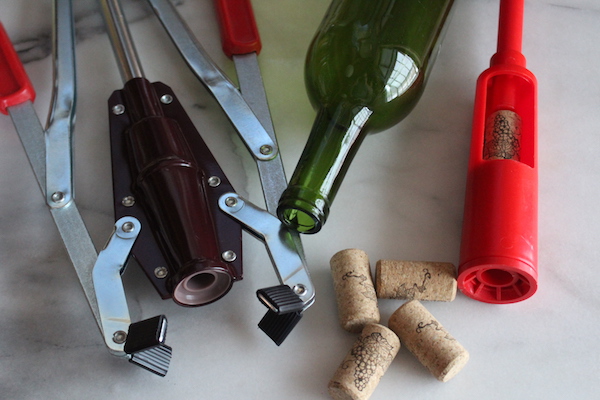
Allow the mead to bottle age for at least a month, but preferably much longer for the best flavor.
This basic process covers how to make mead, good mead, at home with minimal equipment. If you’re still nervous, you can always start with a micro-batch mead in a quart or half-gallon mason jar to get familiar with the process (without spending a lot of money on equipment or ingredients). Even after making mead for more than a decade I still do my experiments in small batches. There are plenty of reasons to make micro-batch mead, it’s not just for beginners.
Types of Mead
Part of the fun in making your own mead is experimenting with flavors. Fruits and herbs were traditionally added to meads, and according to Ancient Brews, most of the ancient brews cataloged by historians were actually mixed brews containing grapes, honey, apples, grains, and herbs rather than simple single ingredient ferments.
Ancients were trying to add as many nutrients as possible to help feed the yeasts and make potent fermented beverages. Yeast nutrient and efficient modern yeast strains do that work these days, and now we’re just adding flavor instead.
Quick Mead
A quick mead is basically a mildly alcoholic yeast fermented soda. The total fermentation time is very short, usually just a few days. The mead has just enough time to develop carbonation as the yeast activates, but most of the honey is left in the finished brew.
Sima, or Finnish Fermented Lemonade, is a type of quick mead.
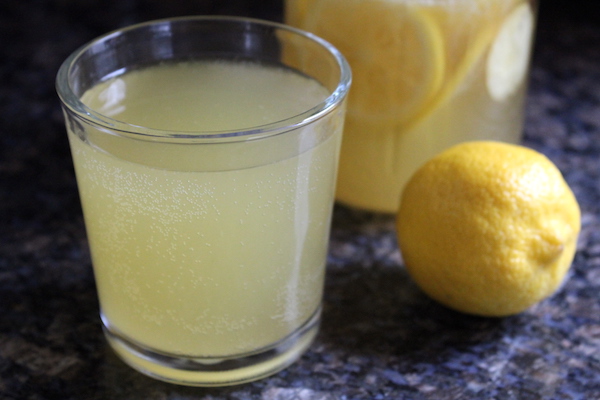
Herbal Mead (Metheglin)
Long ago, meads were an efficient way of preserving herbs, and there were few more pleasant ways to get a reluctant patient to take their medicine. Medicinal herbs like yarrow were common, as were spices like cloves and cinnamon.
Generally, herbal and spiced meads are called Metheglin.
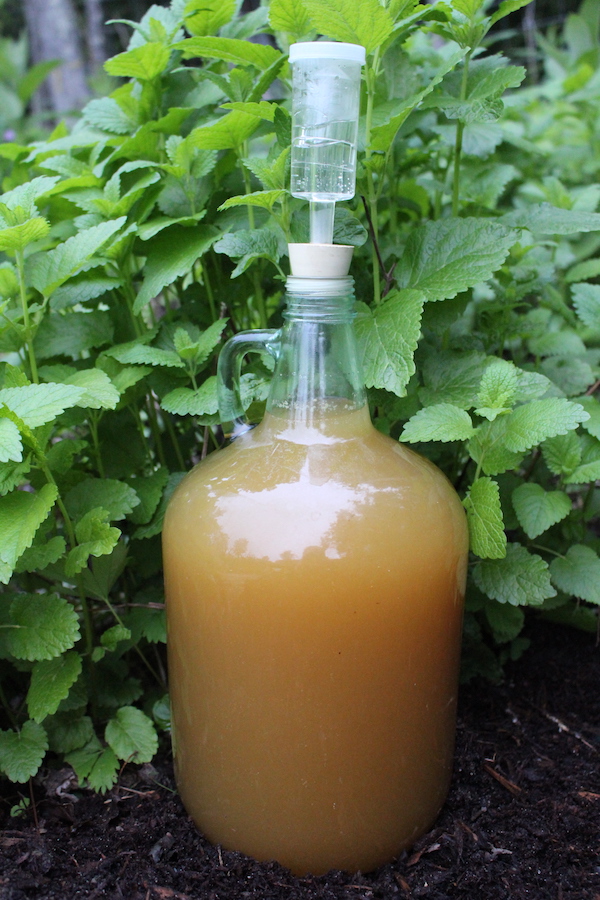
Fruit Meads (Melomel)
Fruit adds more fermentable sugars to mead, as well as complex flavors and rich colors. While all fruit meads can be called melomel, some common fruits get their own special names. When you add apples to mead it’s called cyser, and with grapes, it’s called pyment.
Names get complicated fast, but whatever you call them, they’re delicious. Try any of these Melomel recipes:
Sometimes meads blur the line between “fruit” and “herbal,” incorporating medicinal herbs and fruits at the same time. Good examples include Elderberry mead, Elderflower Chokecherry Mead and hawthorn & rosehip mead.
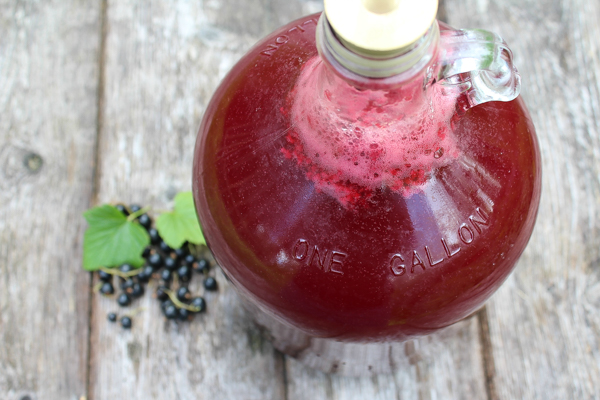
Mead Making Books & Resources
Mead making has had quite the resurgence lately, and we’re blessed with many modern books and resources to answer every mead making question under the sun.
Make Mead Like a Viking ~ As the title says, this is a great guide to making mead without a lot of equipment or complications. Traditional no-fuss methods, and a lot of history along the way.
The Compleat Meadmaker ~ If you’re looking for a more scientific approach to mead making, the compleat meadmaker covers every possible additive and variation. When you start using Irish moss to clarify mead or adding oak chips for a really fancy bottle, this book will cover everything you need to know to make a spectacular bottle of mead.
Artisanal Small Batch Brewing ~ Written by Amber from Pixie’s Pocket, this book includes many easy mead recipes perfect for beginner and experienced brewers. All recipes are one-gallon batches, and she prefers high-quality ingredients and natural methods rather than brewing chemicals.
The Big Book of Mead Recipes ~ Includes 60 mead recipes from basic batches to experimental meads.
Making Wild Meads and Wines: 125 Recipes Using Herbs, Fruits, Flowers and More ~ The title says it all. I got this one early on in my mead journey and it really instills a spirit of exploration in a budding mead maker.
The Art of Fermentation ~ The ultimate guide to ferments of any type, and it has an exhaustive section on meads (as well as ferments from around the world). If you’re getting into the world of cultured foods, I can’t recommend this one highly enough.
The Craft of Herbal Fermentation Course ~ By the Herbal Academy of New England, this online course includes videos, printables, and coursework that covers everything you need to know to get you fermenting. Homemade mead, ale, wine, and beer are covered, as well as how to incorporate herbs into your brews. Whether you’re planning on brewing with herbs or not, it’s still an excellent resource with a lot of spectacular videos of the whole process.
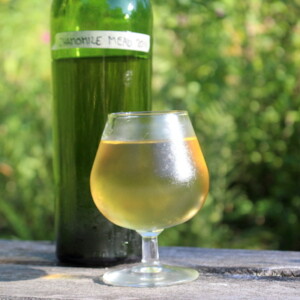
Mead (Honey Wine)
Equipment
Ingredients
- 3 lbs Honey
- 3 quarts water, plus more to top off
- 1 wine yeast, Lavin QA23 Suggested
- 1 tsp yeast nutrient
- Optional ~ Fruit or Herbal Flavorings
Instructions
- Sanitize all equipment using one-step brewing sanitizer.
- Mix the honey, water, and yeast nutrient. Stir to completely dissolve. If necessary, gently heat the water until the honey is completely dissolved, then allow everything to cool to room temperature.
- Place the honey/water mixture in the fermentation vessel.
- Dissolve a packet of mead yeast in a small amount of water (1/4 cup). Allow it to "bloom" for about 10 minutes, then add the yeast & water mixture to the honey/water mixture.
- Cap with a water lock and rubber stopper. You should see active fermentation within 24 to 48 hours.
- Allow the mixture to ferment for 2-3 weeks at room temperature (or slightly colder), until fermentation slows. If the mixture bubbles up into the water lock, carefully remove it and clean it out before re-sealing the container.
- When fermentation slows, use a siphon to rack the mead into a clean fermentation vessel, leaving any sediment behind.
- Allow the mixture to ferment in secondary for at least 6 weeks, but preferably much longer (like 6 months).
- Bottle the mead, filling only to the base of the bottleneck.
- Soak the corks in hot water until pliable, then cork the bottles using a bottle corker.
- Allow the mead to bottle age for at least a month before drinking, preferably much longer. Like a year (or ten).
Notes
Nutrition
Nutrition information is automatically calculated, so should only be used as an approximation.
More Fermented Beverages
Looking for more fun homemade alcohol projects?
- How to Make Small Batch Wine
- Blackcurrant Liqueur
- Homemade Herbal Gin
- Homemade Hard Cider
- Pear Cider (Perry)
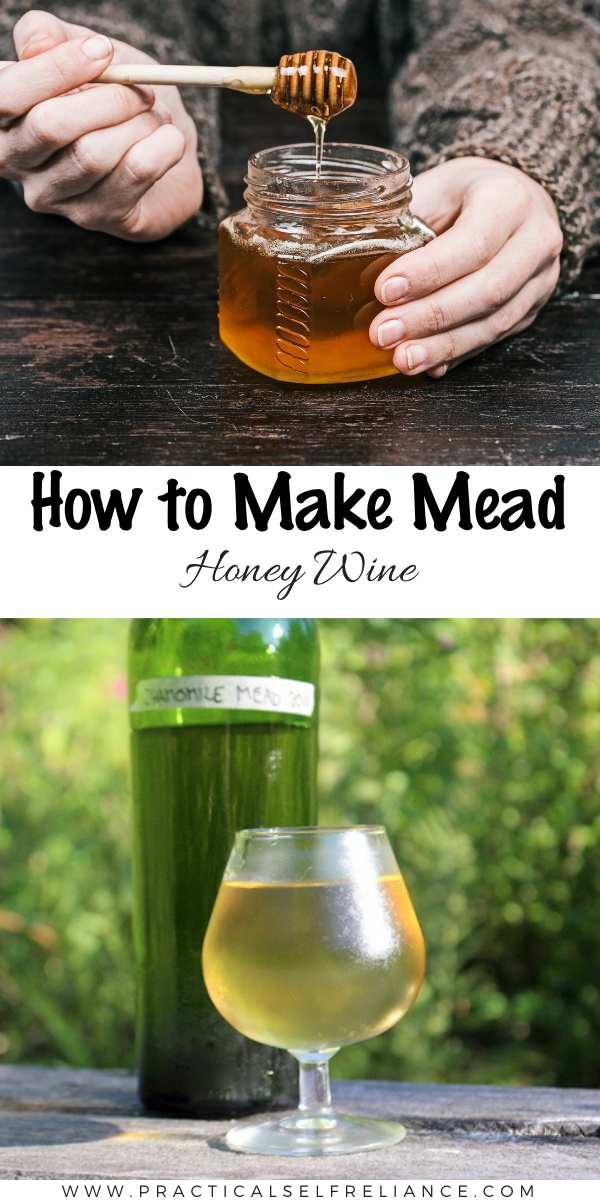


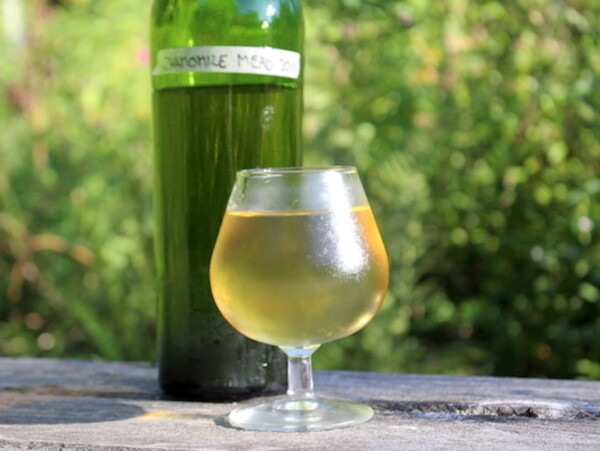
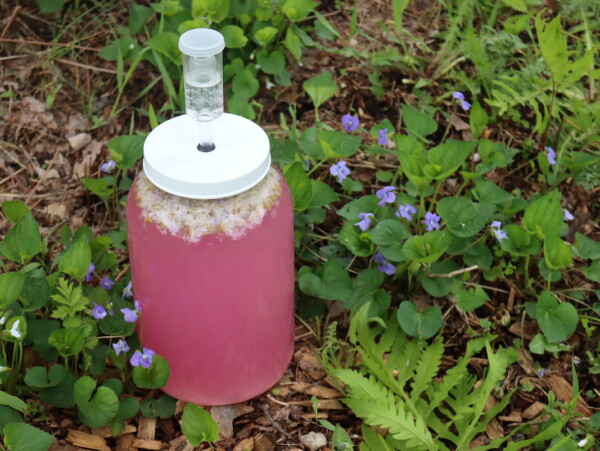










Hi Ashley,
Thank you for your wonderful blog, I am learning a lot with you and trying home brewing. I have racked my mead after 3 weeks and on the second day after racking the bubbling has stopped completely and the airlock lost all pressure. Before racking it would bubble around every 10 seconds. Is this normal and should I still wait 6 weeks before bottling or can I do it sooner? Thank you so much for answering.
This is totally normal during the second ferment. I would still wait to bottle.
Great site! Although I didn’t realize one had to wait months and months to be able to enjoy home-made mead. I figure that first gallon is going to be drunk pretty quickly and then I’ll have to wait a few more months for more.
If you stagger out your batches, then you can have an endless supply after a while.
Hi there ! I followed this mead recipe and have left it in secondary since April of 2021. It was tasty after the first rack but kept it in secondary in the basement until today. Just brought it up from the basement to bottle and darn if I didn’t hear 5-6 bubbles every once in awhile coming from the air lock while getting everything ready for bottling 10 months later.. I’m now hesitant to bottle and am thinking carrying it upstairs shifted some of the sediment. Should I sit tight to wait even longer? Thank you for your help because this will be my first of your brew batches to bottle but have a handful of others waiting for their 6 month mark.
It should be ok to bottle by now. I am surprised that you would be seeing activity in the air lock. You shouldn’t have much issues with sediment either since most of that should have been left in the primary vessel when you racked it into the secondary. What is the temperature in your basement?
Hey Ashley,
I’ve recently started fermenting (using your blog as help) and I really enjoy a lot of kitchen witchery. My husband put the idea in my head of making a 1 gallon batch of mead, just for the fun of it. I came here looking for some idea of what all that would entail and I’m trying to keep to the more ‘natural’ way of things. I don’t like using a lot of sanitizers and clean most of my kitchen with herbs and hot water.
I’ve read several instructions on making mead and I’m trying to understand the sanitizing process. Viking ancestors would not have access to these sanitizing mixings and I’m trying to understand why I couldn’t just boil my equipment and use it then. I understand we do not want the bad bacteria in the mix, but would just boiling my pots, spoons, ect work just as well (or well enough)?
I imagine that you could boil everything if you had a pot big enough to boil everything in. You also want to be sure that your water is not leaving any mineral deposits on your equipment as it boils which could affect the flavor.
Hi Ashley,
Any idea of the ABV (alcohol by volume) of the finished product with your standard recipe? I tend to prefer stronger drink, so wondering how yours turns out. Thanks as always.
I don’t believe that this is something that Ashley typically measures.
Not sure I would take the trouble to measure it either, so no biggie. But one could guess, right, based upon the taste or the brew’s effect?
The berries in my mead have turned white. Is this okay or does it denote a problem? Otherwise, it is still bubbling after about 6 weeks. Should I siphon it off to finish fermentation or leave it alone?
That’s totally fine, and lots of fruit bleach in winemaking and mead-making. If the berries have been in there a few weeks, I’d siphon it off. If they’re floating above the water line they can mold and cause problems later. It’s good to get them out of there once they’ve contributed all they can in terms of flavor and sugar.
Hello:) I am in the process of making my first mead. It’s been 2 weeks and 3 days since it started its first fermenting. Everything has been working like it should and I noticed today that there are no more bubbles in the water lock. I am assuming that the fermentation has slowed. I won’t be racking this batch, so is it ready to drink? I am planning on just bottling it for my husband to drink. What do you suggest? I don’t want to spoil it.
Sorry we didn’t see your comment sooner. What did you end up doing and how did it turn out?
I have a gallon of this bubbling right now 🙂 it’s been 2 weeks and I’m thinking I should rack into the secondary. Can you add water to make up for what you lose and to close the air space?
I can’t wait to try this! Waiting is certainly the hardest part of wine making!
Sorry we are just now seeing your comment. How did it turn out for you?
It’s sitting and clearing now.. I snuck a little taste and it’s going to be good 🙂
That’s awesome. So good to hear.
I’ve brewed many, MANY batches of beer in the past and never really had any issues. I decided to try a batch of mead, so I bought a kit, bought pure honey and made it according to the instructions. I started it a little over a week ago and so far there is no activity. I stir it daily per the instructions. If I don’t stir it, I shake the fermenter well and check the seal to make sure it isn’t leaking. i just stirred it and honestly the smell is AWEFUL. It smells like super strength vinegar on steroids. Do you think this batch is toast? I’ve never smelt anything like it before. Like I said, I’ve made lots of beer and even wine in the past but this is the first time making mead. Just wanted to get your thoughts on this. Thanks! Keep up the great work and content!!!
It definitely sounds like something is not quite right with your batch. You should see bubbles within the first 24 hours. Did you add yeast to the mead? And what kind of lid are you using?
I was using a 1 gallon fermenting bucket with a grommet lid and airlock. I ended up tossing that batch yesterday and starting a new one. I followed a new recipe that actually uses Fleischman’s Active Dry Yeast, Raisins, orange peels. I made that must yesterday and within a couple hours I had airlock activity. I’m holding out a lot more promise for this batch for sure. Thanks for the response!
I’ve been making small batch Mead and methaglin for years. Some has fermented out to 18%by volume I’m in England and having read your recipe will try that this year
Dear Ashley,
I religiously read every one of your recipes, instructions, comments etc. I love whole idea of being independent in food preparation. It is hard labor, but it is worth it. Thank you very much.
This time I wanted to add something. You may know it already or not, doesn’t matter. It is about making Mead.
Honey vine. MED is actually Slavic word for honey in Serbian which is mine background. Russian word is MJOD, and I assume it is similar in all other countries with the same Slavic language base. It is obviously very old word.
The alcohol beverage made in our countries is called MEDOVINA, and is quite similar to that wine of yours.
Thank you very much once again
Sincerely, Slobodanka Zebic
Thank you so much!
I’m excited to try this! Question for you. I’ve had some honey long enough that it is quite crystallized. It should mostly dissolve if I heat it with the water, but I’m not sure if that would totally cure it. Do you see any issue with using that honey in my mead?
I would probably warm your honey long enough that it returns to its liquid form before stirring it into the water for the mead if only to be sure that it fully dissolves.
Wine of honey. Curiosity: durrazzo is one of the first places for this alcoholic drink. Ancient city of Illyrian. The Bee was a symbol of a lot of old iyllirian coins. A lot of ancient authors have mentioned this honey wine is produced massively by illyrians. Aristotle and Strabo (Greek philosophers and historians) also Gaius Plinius Secundus have mentioned this that they were impressed, that Taulantus tribe was very good at making it, it had very good quality and it was distributed by illyrian sailors to danishes, idinos (German), thori from pantheon of vikings,ecc.
Aristotle in his book (de mirabilibus auscultationibus) mentions: they say that illyrians named taulantis they squeeze honeycombs they mix it with water and boil it until it remains half then they put it in wood containers and leave it to get fermented for a long long time. At the end it is a sweet and strong honey wine. At his last words about this magic wine Aristotle mentioned that now they produce it in Hellada (old greece) too, and it’s quite impossible to know the difference.
They said that it was used by gods and it had healing powers.
Wow, thanks for sharing! Mead goes back a long way!
Illyrian (Illyric) are people lived on Balkan peninsula, wrongly identified lately as Albanian. But it is pure political reason.
Some Albanian tribes were in Little Asia at that time, nowhere close to Balkan. What is called lately Slavic people origins partially from Illyric. In our very old epic songs Medovina (honey wine) is mentioned many times. Yes, it does go way, way back, and obviously still holds . Cheers!
hi from new mexico – this is awesome i am excited to make my own wine. thank you very much
Wonderful, I wish you good luck and happy sips!
Ashley, wonderful article, thank you! My friend and I are looking to make mead commercially in Bali, Indonesia and are wondering if you are interested in consulting. Thank you so much, Brady.
Hey Brady! Congrats on your venture, and so nice of you to think of me. I can’t say that I feel qualified to advise on anything commercial quite frankly. I’d suggest maybe trying Jereme Zimmerman (http://www.jereme-zimmerman.com/), I don’t know him personally, but I love his books and I believe he does that type of work. Good luck!
This is, by far, the best recipe, and process explantation I’ve used. My last batch of Mead, using a different process, turned out okay, but a little off because I boiled it. This explained why I didn’t need to and what would happen if I did. Easy to follow instructions, fun memory about making Mead in a moving vehicle. Can’t wait to drink this when it has aged enough.
Started mine today, all but the bottles came in and I figured ot would be a good time. We have some wild Blackberry and Muscadine bushes so once those bloom I will be real excited about throwing some of them in! Can’t wait to see how it goes!
Pennsic was my first experience with Mead as well. Now we make it at home and bring it to SCA events for other people to try. Such a fun and delicious hobby!
As a new resident in VT, anything I can read about local gardening, preserving, homesteading thrills me!! I am thoroughly enjoying your posts! Looking forward to trying my hand at Honey wine and Sima~lemonade.
Thank you!
Deanna
Wonderful and welcome to Vermont!